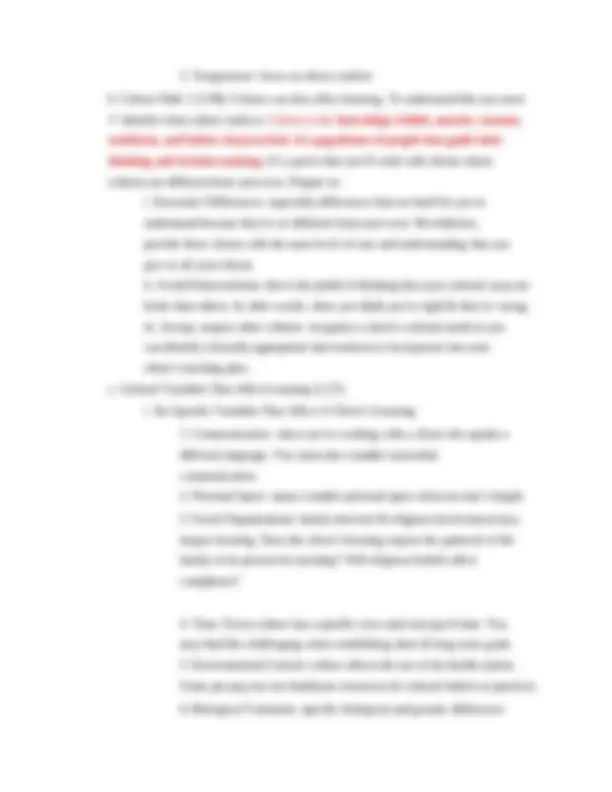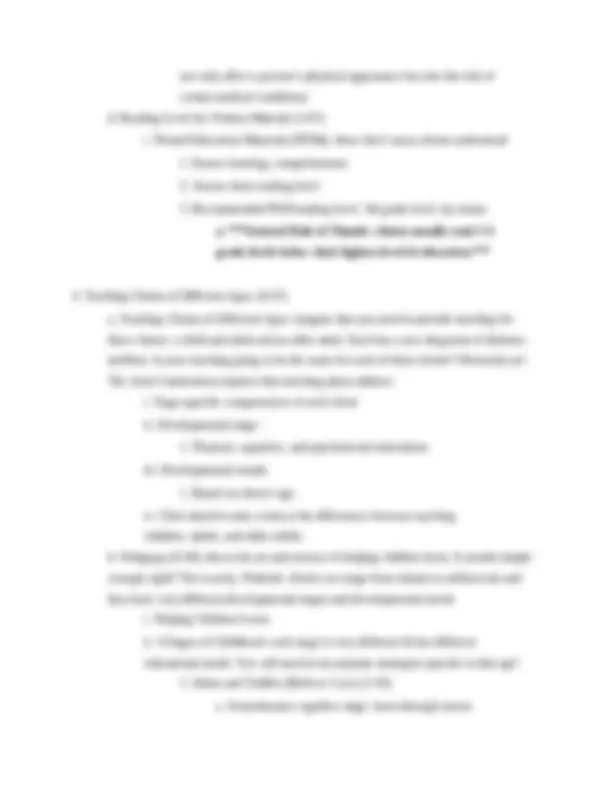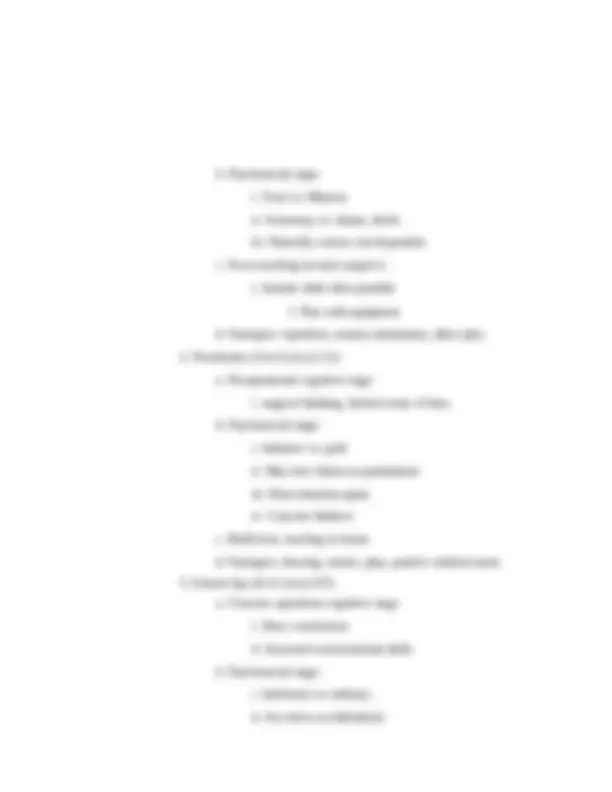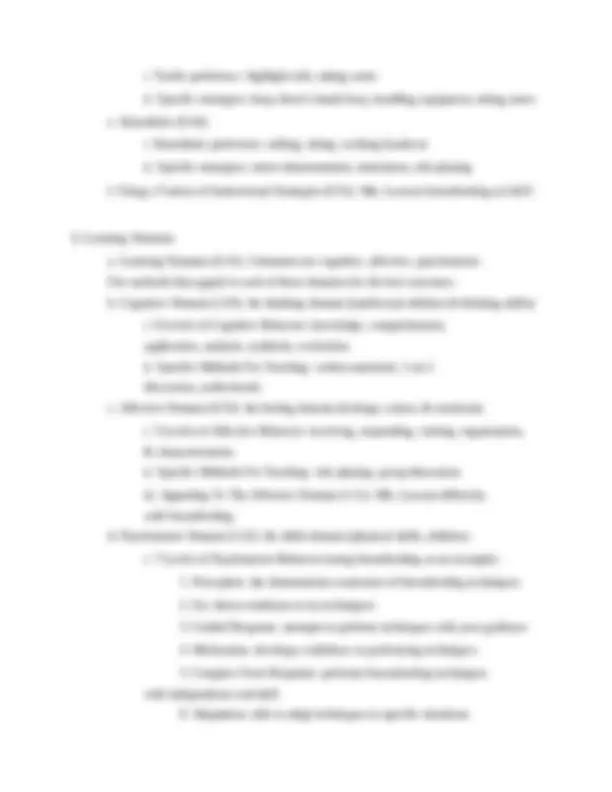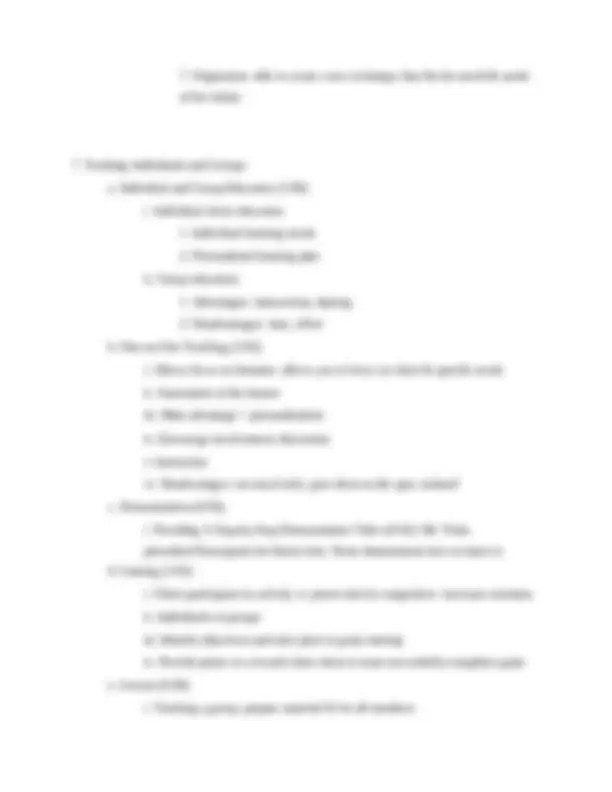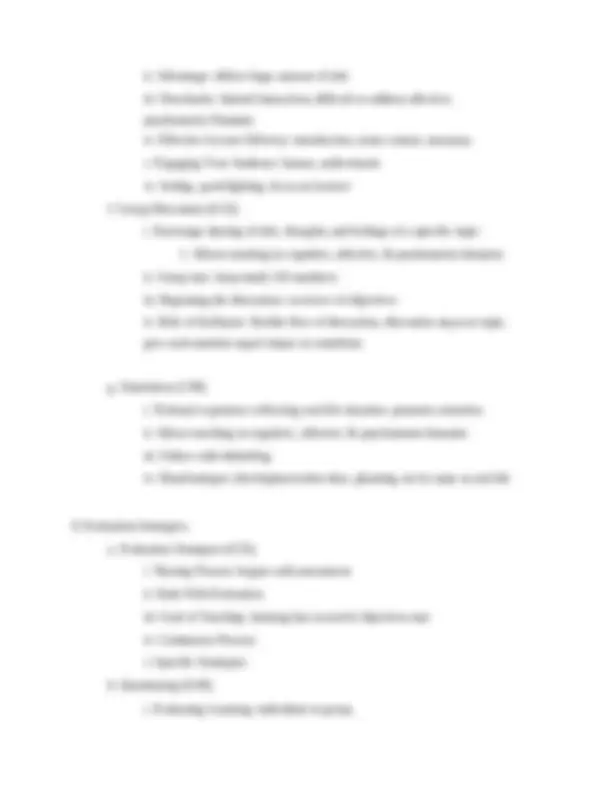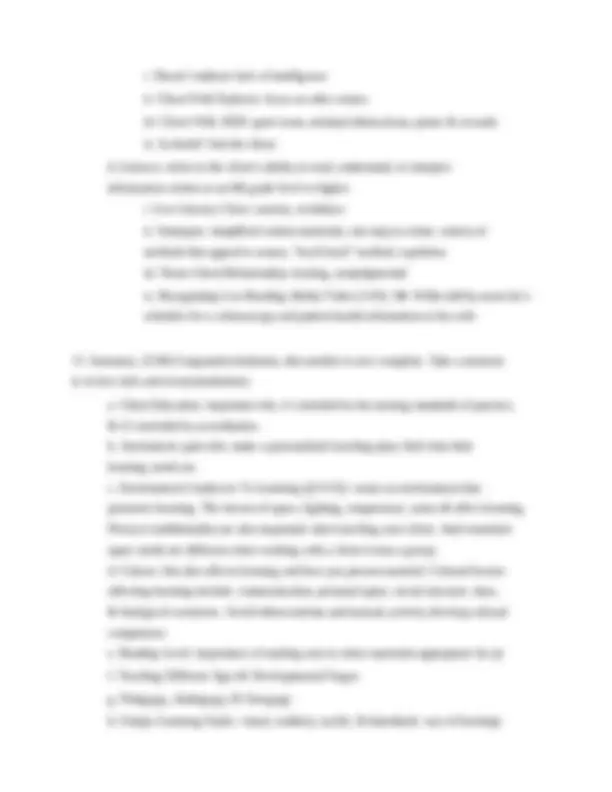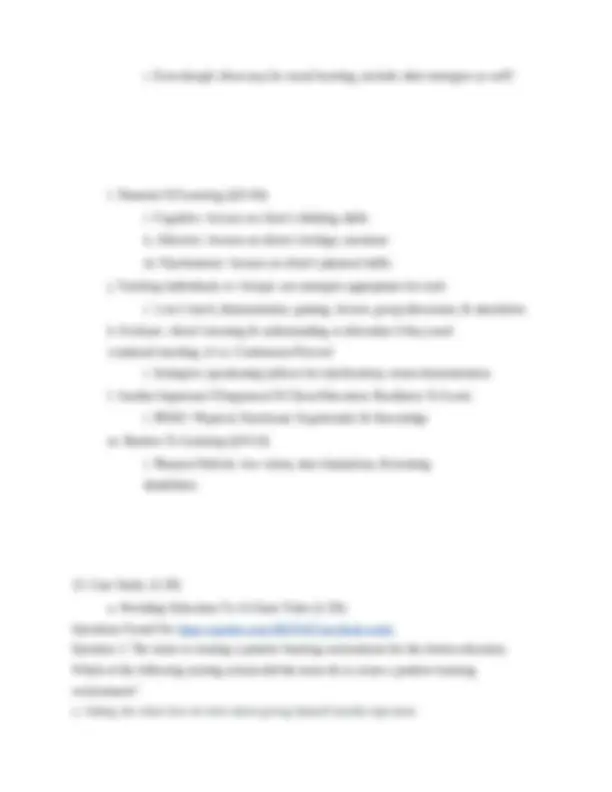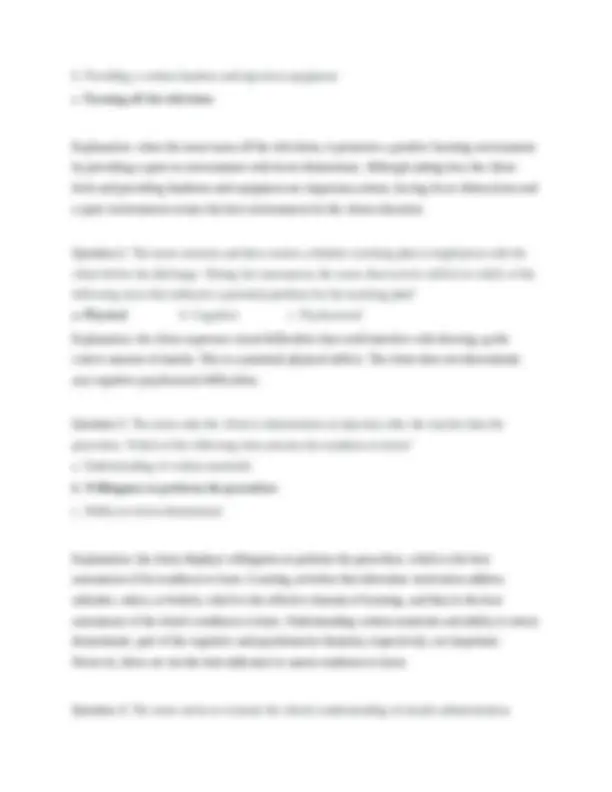Download Client Education for Nurses and more Study notes Nursing in PDF only on Docsity!
NR 222ATI Nurses Touch_ Professional Communication - Client Education
(2_33_04 Spent Typing These Notes). Chamberlain College of Nursing
ATI Nurse's Touch: Professional Communication - Module 1 - Client Education Welcome to the module on client education. In this module you learn about client education and why it's such an important part of being a professional nurse.
- Introduction. (2:12) You'll discover your role in providing:
- Client Education: including...
- Identifying client’s needs
- Best environment, materials
- Teaching clients of different age groups
- As well as teaching the motivation for different types of learning
- You’ll also discover which approaches are more appropriate for teaching a child vs. teaching an older adult.
- In addition to age differences you’ll look at:
- Different teaching approaches
- Best way to learn
- Observe, hands-on
- You’ll also look at the different domains of learning: Cognitive, Affective, Psychomotor
- And how the different domains of learning affect your clients’ comprehension of info.
- Individual client teaching vs. Group teaching
- Role of a Nurse. a. Client Educator (1:14) i. Assessment of the Client (1:00): 1. Where to begin:
a. Assessment or data collection b. Determine individual needs prior to ever providing for a patient ii. Client’s Learning Needs (1:11): When determining your patient’s educational needs, the most basic question you need to ask is “What does my client need to Learn?” The Healthcare Education Association defines “learning needs” as gaps in knowledge that exists between the desired level of performance and the actual performance. To identify your client’s learning needs, you need to:
- Influencing Factors: concerns, experience, support, motivations
- Assessment Methods: a. Conversation or observation b. Interviews, questionnaires, or records
- Personalized Plan: promotes most favorable outcome iii. Assessing Clients’ Learning Needs (1:13): Mrs. Lawson nervous in L&D
- Learning Environment. a. Best Learning Environment (1:00): What is the best environment? Depends on individual needs vs. group needs as well as content needs. You might need a different setting for teaching a client about the purpose of a medication (e.g. insulin administration). 2 important things to keep in mind when choosing the environment are privacy and confidentiality. i. Promote a Positive Learning Environment Part 1 (1:08): When teaching a client you want to choose a space that is:
- Conducive To Learning: a. Space Requirements: Have enough chairs? Need a table? b. Noise May Disrupt: Construction noise, for example, can hinder c. Limit Interruptions: It’s distracting to have interruptions! ii. Promote a Positive Learning Environment Part 2 (0:57): Creating a learning environment also requires consideration of 2 more elements:
- Light: appropriate for content
not only affect a person’s physical appearance but also the risk of certain medical conditions. d. Reading Level for Written Material (1:07): i. Printed Education Materials (PEMs): these don’t mean clients understand
- Ensure learning, comprehension
- Assess client reading level
- Recommended PEM reading level: 5th grade level, lay terms: **a. *General Rule of Thumb: clients usually read 2- **grade levels below their highest level of education.*****
- Teaching Clients of Different Ages. (0:47) a. Teaching Clients of Different Ages: imagine that you need to provide teaching for three clients: a child and adult and an older adult. Each has a new diagnosis of diabetes mellitus. Is your teaching going to be the same for each of these clients? Obviously no! The Joint Commission requires that teaching plans address: i. Stage-specific competencies of each client ii. Developmental stage:
- Physical, cognitive, and psychosocial maturation. iii. Developmental trends:
- Based on client’s age. iv. Click ahead to take a look at the differences between teaching children, adults, and older adults. b. Pedagogy (0:46): this is the art and science of helping children learn. It sounds simple enough, right? Not exactly. Pediatric clients can range from infants to adolescents and they have very different developmental stages and developmental needs i. Helping Children Learn: ii. 4 Stages of Childhood: each stage is very different & has different educational needs. You will need to incorporate strategies specific to that age!
- Infant and Toddler (Birth to 3 y/o) (1:10): a. Sensorimotor cognitive stage: learn through senses
b. Psychosocial stage: i. Trust vs. Mistrust ii. Autonomy vs. shame, doubt iii. Naturally curious, but dependent c. Focus teaching toward caregiver: i. Include child when possible
- Play with equipment d. Strategies: repetition, sensory stimulation, allow play
- Preschooler (3 to 6 y/o) (1:11): a. Preoperational cognitive stage: i. magical thinking; limited sense of time. b. Psychosocial stage: i. Initiative vs. guilt ii. May view illness as punishment iii. Short attention spans iv. Concrete thinkers c. Build trust, teaching in bursts d. Strategies: drawing, stories, play; positive reinforcement
- School-Age (6-12 y/o) (1:07): a. Concrete operations cognitive stage i. Draw conclusions ii. Increased conversational skills b. Psychosocial stage: i. Inferiority vs. industry ii. See selves as individuals
iii. Strategies:
- Drawing on past experiences
- Encouraging self-directed learning
- Focusing on immediate problem d. Geragogy (0:50): i. Teaching older adults ii. Physical challenges:
- Diminished eyesight, hearing, mobility
- Identify challenges, tailor teaching plan iii. Cognitive challenges:
- Slower processing time, decreased memory, altered time perception iv. Strategies:
- Reminiscence involvement, repetition of info
- Material appropriate for specific challenges
- Learning Styles. a. Learning Styles (1:02): learning styles are: i. How individuals process info: Visual, auditory, tactile. ii. Identify learning styles through: observation, interviews, administer tools b. Visual (0:47): i. Visual preference: reading content; observing demonstration ii. Strategies: handouts to read, videos to watch, demonstration technique c. Auditory (0:44): i. Auditory preference: verbalize info; make sure client restates info. ii. Specific strategies: talk about info, encourage group discussion, use audiotapes d. Tactile (0:39):
i. Tactile preference: highlight info; taking notes ii. Specific strategies: keep client’s hands busy, handling equipment, taking notes e. Kinesthetic (0:44): i. Kinesthetic preference: talking, doing; working hands on ii. Specific strategies: return demonstration, simulation, role-playing f. Using a Variety of Instructional Strategies (0:51): Mrs. Lawson breastfeeding in L&D
- Learning Domains. a. Learning Domains (0:41): 3 domains are cognitive, affective, psychomotor. Use methods that appeal to each of these domains for the best outcomes. b. Cognitive Domain (1:03): the thinking domain (intellectual abilities & thinking skills): i. 6 Levels of Cognitive Behavior: knowledge, comprehension, application, analysis, synthesis, evaluation. ii. Specific Methods For Teaching: written materials, 1-on- discussion, audiovisuals. c. Affective Domain (0:55): the feeling domain (feelings, values, & emotions) i. 5 Levels of Affective Behavior: receiving, responding, valuing, organization, & characterization. ii. Specific Methods For Teaching: role playing; group discussion iii. Appealing To The Affective Domain (1:11): Mrs. Lawson difficulty with breastfeeding. d. Psychomotor Domain (1:22): the skills domain (physical skills, abilities) i. 7 Levels of Psychomotor Behavior (using breastfeeding as an example): 1. Perception: she demonstrates awareness of breastfeeding techniques 2. Set: shows readiness to try techniques 3. Guided Response: attempts to perform techniques with your guidance 4. Mechanism: develops confidence in performing techniques 5. Complex Overt Response: performs breastfeeding techniques with independence and skill 6. Adaptation: able to adapt techniques to specific situations
ii. Advantage: deliver large amount of info iii. Drawbacks: limited interaction; difficult to address affective, psychomotor Domains. iv. Effective Lecture Delivery: introduction, main content, summary v. Engaging Your Audience: humor, audiovisuals vi. Setting: good lighting, focus on lecturer f. Group Discussion (0:52): i. Encourage sharing of info, thoughts, and feelings of a specific topic:
- Allows teaching in cognitive, affective, & psychomotor domains ii. Group size: keep small; 6-8 members iii. Beginning the discussion: overview of objectives iv. Role of facilitator: flexible flow of discussion; discussion stays on topic; give each member equal chance to contribute. g. Simulation (1:08): i. Fictional experience reflecting real-life situation: promotes retention ii. Allows teaching in cognitive, affective, & psychomotor domains iii. Follow with debriefing iv. Disadvantages: development takes time, planning; never same as real life
- Evaluation Strategies. a. Evaluation Strategies (0:55): i. Nursing Process: begins with assessment ii. Ends With Evaluation iii. Goal of Teaching: learning has occurred; objectives met iv. Continuous Process: v. Specific Strategies: b. Questioning (0:49): i. Evaluating Learning: individual or group.
ii. Actively ask client for info: doesn’t threaten client iii. Attentively listen, clarify c. Return Demonstration (0:54): i. Psychomotor Skill Following Demonstration ii. Promotes Client Success: has necessary equipment; cues available iii. Opportunity For Observation: determine client understanding, need for additional teaching. iv. “Teach Back” Method: adds cognitive domain v. Learning Through Return Demonstration Video (0:50)
- Readiness to Learn. a. Determining a Client’s Readiness to Learn (0:56): Susan Bastable defines “readiness to learn” as the the time when the learner expresses or shows interest in learning the information necessary to maintain optimal health. i. PEEK (Factors Affecting Readiness To Learn): Physical, Emotional, Experiential, Knowledge b. Physical Readiness (1:06): 5 factors: measures of ability, complexity of task, environment effects, health status, gender i. Postponing Learning Video (0:49): Mrs. Lawson given review of bathing baby & she starts having cramps. Nurse says she’ll teach when she feels better. c. Emotional Readiness (0:56): i. Factors: anxiety level, support system, motivation d. Additional Factors of Emotional Readiness (1:12): i. Risk-Taking Behavior: address needs; develop strategies to minimize risk ii. Frame Of Mind: Primary concerns; willingness to learn iii. Developmental Stage e. Experiential Readiness (1:15): i. 5 Components:
i. Doesn’t indicate lack of intelligence ii. Client With Dyslexia: focus on other senses iii. Client With ADD: quiet room, minimal distractions; praise & rewards iv. In doubt? Ask the client. d. Literacy: refers to the client’s ability to read, understand, or interpret information written at an 8th grade level or higher. i. Low Literacy Clues: anxiety, avoidance ii. Strategies: simplified written materials; one step at a time; variety of methods that appeal to senses; “teach back” method, repetition. iii. Nurse-Client Relationship: trusting, nonjudgmental iv. Recognizing Low Reading Ability Video (1:03): Mr. Willis told by nurse he’s schedule for a colonoscopy and patient hands information to his wife.
- Summary. (5:00) Congratufuckulations, this module is now complete. Take a moment to review info and recommendations: a. Client Education: important role, it’s included in the nursing standards of practice, & it’s included in accreditation. b. Assessment: gain info, make a personalized teaching plan, find what their learning needs are. c. Environment Conducive To Learning (@ 0:52): create an environment that promotes learning. The factors of space, lighting, temperature, noise all affect learning. Privacy/confidentiality are also important when teaching your client. And remember space needs are different when working with a client versus a group. d. Culture: this also affects learning and how you present material. Cultural factors affecting learning include: communication, personal space, social structure, time, & biological variations. Avoid ethnocentrism and instead, actively develop cultural competence. e. Reading Level: importance of making sure to select materials appropriate for pt f. Teaching Different Ages & Developmental Stages g. Pedagogy, Andragogy, & Geragogy h. Unique Learning Styles: visual, auditory, tactile, & kinesthetic way of learning/
i. Even though client may be visual learning, include other strategies as well! i. Domains Of Learning (@2:44): i. Cognitive: focuses on client’s thinking skills ii. Affective: focuses on client’s feelings, emotions iii. Psychomotor: focuses on client’s physical skills j. Teaching Individuals vs. Groups: use strategies appropriate for each: i. 1-on-1 teach, demonstration, gaming, lecture, group discussion, & simulation k. Evaluate: client’s learning & understanding to determine if they need continued teaching, it’s a: Continuous Process! i. Strategies: questioning (allows for clarification), return demonstration l. Another Important COmponent Of Client Education: Readiness To Learn: i. PEEK!: Physical, Emotional, Experiential, & Knowledge m. Barriers To Learning (@4:14): i. Physical Deficits: low vision, time limitations, & learning disabilities.
- Case Study. (1:29) a. Providing Education To A Client Video (1:29): Questions Found On: https://quizlet.com/40679167/ati-flash-cards/ Question 1: The nurse is creating a positive learning environment for the clients education. Which of the following nursing actions did the nurse do to create a positive learning environment? a. Asking the client how he feels about giving himself insulin injections
Which of the following methods did the nurse use to evaluate the client's learning? a. Questioning b. Interviewing c. Observing Explanation: evaluation using observation requires direct visualization of the Learners physical, verbal, psychomotor, and affective behaviors. Questioning and interviewing are important parts of the educational process and should be included, but they are not the best methods to evaluate the client's learning. Question 5: The nurse is assessing the client's readiness to give himself insulin injections. Which of the following statements by the client demonstrates his readiness to learn? a. I'm not crazy about it, but I guess it has to be done. b. I guess I worry about my eyesight and looking at those little lines on the syringe. c. Is there a way that we can practice today before we leave. Explanation: Asking, “Is there a way that we can practice today before we?”, demonstrates motivation to learn by practicing the scale before discharge. It is a positive indicator of learner readiness. “I'm not crazy about it, but I guess it has to be done” indicates reluctance. “I guess I worry…” indicates a concern.

